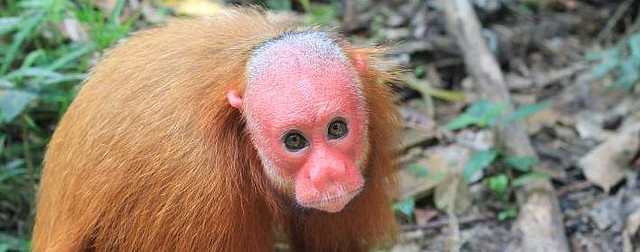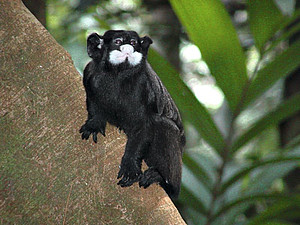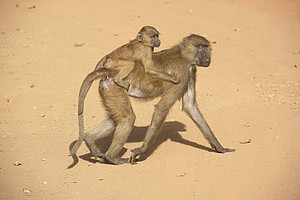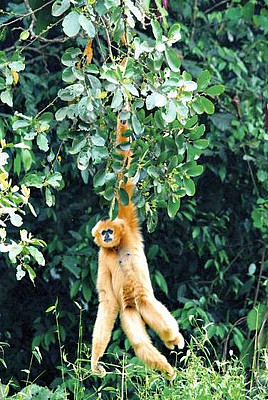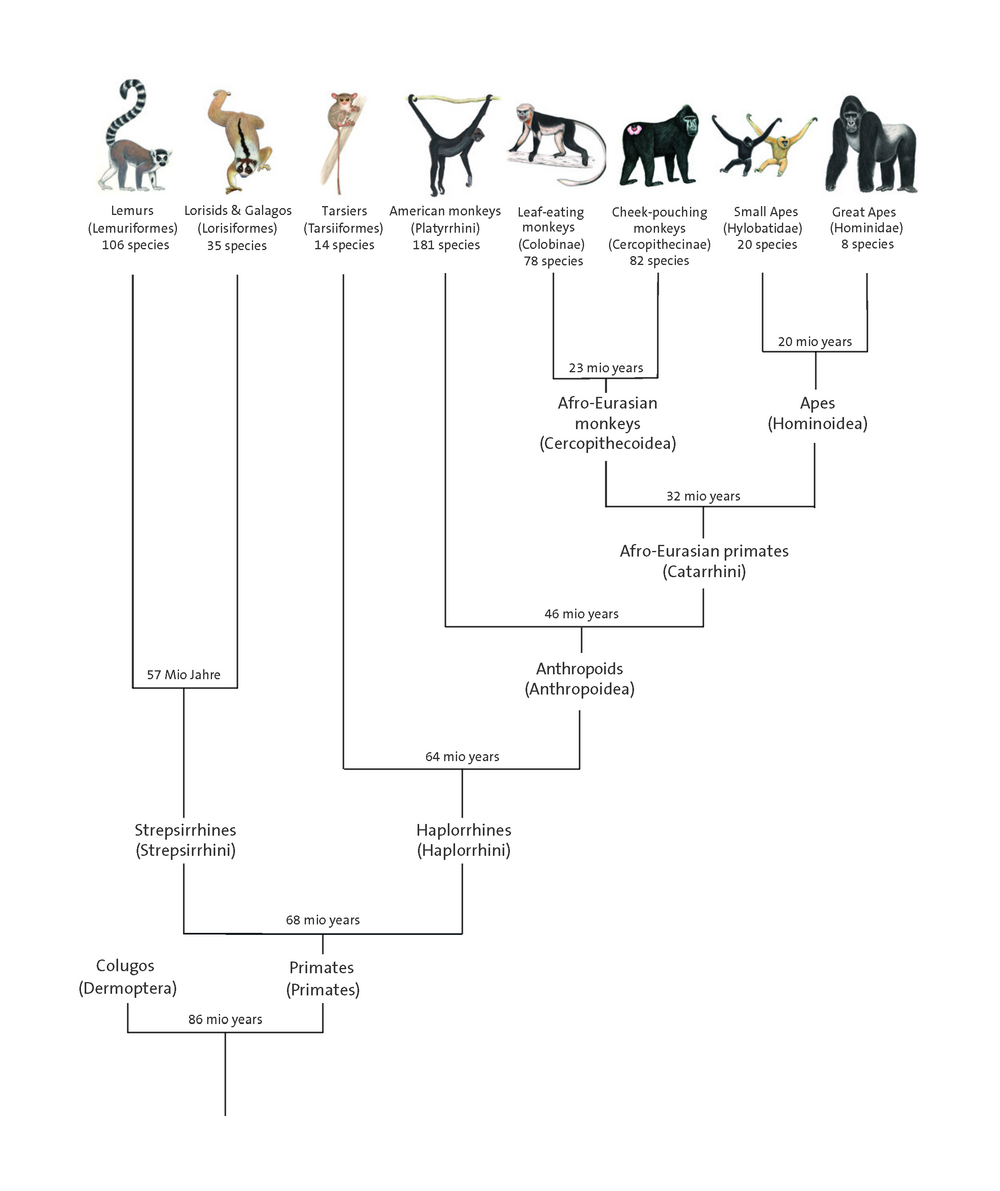If one takes a look at the living primate species, one encounters an astounding variety of sizes, appearances and specializations so that one sometimes considers it incredible that we all have a common ancestor. This common ancestor originated about 80 million years ago when the so-called Primatomorpha split up in the ancestors of today's colugos (Dermoptera) and the first primates. The closest relatives of the primates are therefore not, as long believed the Treeshrews (Scandentia), but cat-sized mammals, whose characteristic is a membranous structure that covers all its extremities and the tail that allows the animals to glide from tree to tree (Mason et al 2016). While only two colugos species are known in Southeast Asia, more than 500 primate species from 16 different families are known. The number of species has increased rapidly in the last 20 years due to the new possibilities of species differentiation using genetic methods (Estrada et al., 2017)
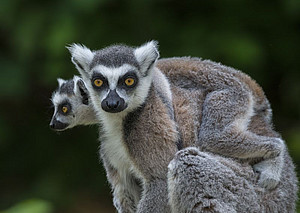
The diversification of primates began about 68 million years ago with the splitting in strepsirrhini and haplorrhini (Finstermeier et al. 2013), clearly recognizable by their wet hairless nose or her dry hairy nose. In the strepsirrhini we can now distinguish between two groups, the lemurs (Lemuriformes) and the lorisoidea (Lorisiformes). Lemurs are exclusively found in Madagascar and the Comoros and comprise five families of 106 species that includes the smallest primates in the world, the mouse lemurs. Galagos and lorisids are members of the superfamily, lorisoidea. While the African galagos use their long hind legs to move, the thumb and the big toe of the slow moving loris are opposable and the second finger or toe much shorter, which earned them the name "gripping tongs climber".
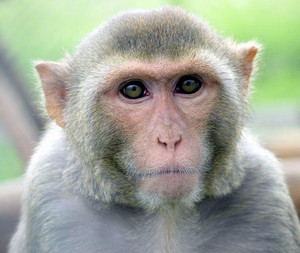
64 million years ago, the strepsirrhini and its counterparts, the haplorrhini split into the tarsier (Tarsiformes) and the actual monkeys (Anthropoidea). Eleven species of the family of small nocturnal tarsiers with enormous eyes lives in Southeast Asia. About 46 million years ago, they were split into American monkeys (Platyrrhini) and Afro-Eurasian primates (Catarrhini), which, as their names suggest, are native to South and Central America or Africa and Asia. A feature to clearly distinguish the American and Afro-Eurasian primates is the shape of the nose. Whereas in the case of the American monkeys the nasal septum is wide and the round nostrils point outward, in the Afro-Eurasian primates the nasal septum is narrow, the nostrils have less space between them and point to the front or down.
American monkeys include 181 species in five families; some of them have particular characteristics. With the exception of the big toe, the nails of the marmosets (Callitrichidae) are claw shaped that allow the small animals to climb tree trunks. On the other hand, the back of the bottom part of the tail of the atelidae is hairless and equipped with tactile fields that serves as a grasping tail and is often called the Fifth Hand.
About 31 million years ago the Afro-Eurasian primates split into the Cercopithecoidea and the Hominoidea. The Afro-Eurasian monkeys (Cercopithecinae) are a family of catarrhines of 160 different species. One differentiates between two large subfamilies, the colobine monkeys (Colobinae) and the Cercopithecinae. Colobine monkeys are found in both Africa and Southeast Asia, and have more or less specialized in a leaf diet. For this they have a multi-chamber stomach with cellulose-degrading bacteria, similarly to that of the ruminants. The Cercopithecinae, a subfamily of the Afro-Eurasian monkeys, are omnivores and just like the hamsters, they can store their food in their cheek pouches. The Cercopithecinae include the most famous primate species, such as baboons, rhesus monkeys or the Mandrills with their colorful faces.
In the human-like apes, one distinguishes between the so-called small apes, the gibbons (Hylobatidae) and the great apes (Hominidae). The two families were separated about 20 million years ago. Gibbons are tree dwellers and live in small family communities in the rain forests of Southeast Asia. The small and the great apes do not have tails. There are 20 different gibbon species. The great apes consist of the three orangutan species, two gorilla and two chimpanzee species as well as the last of the living Homo sapiens. While the orangutan and the gorillas separated from the other apes 15 and 8 million years ago, the last common ancestor of humans and chimpanzees lived until about six million years ago (Mittermeier et al. 2013).
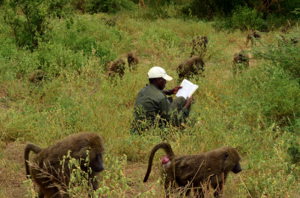
Are humans descendants of apes?
For scientifically educated humans, it nowadays goes without question that all living beings are a product of evolution and that a common ancestor for all living primates including humans existed. The problem therefore seems to be of semantic nature: How do we call our common ancestors? The scientifically correct term would be "primate". In German-speaking science, the Anthropoidea, the group that has separated from the Tarsier after splitting of the “dry-nosed” primates, is referred to as the "real monkey" and in more recent literature only as "monkeys". These include all families of the American and Afro-Eurasian primates, including apes - and thus humans. If one referred to the first anthropoids that lived 64 million years ago as a monkey, one must logically assume that our ancestors of the last 64 million years were monkeys. However, there is only one logical answer to the question: not only are humans descendants of primates, but is one too.

